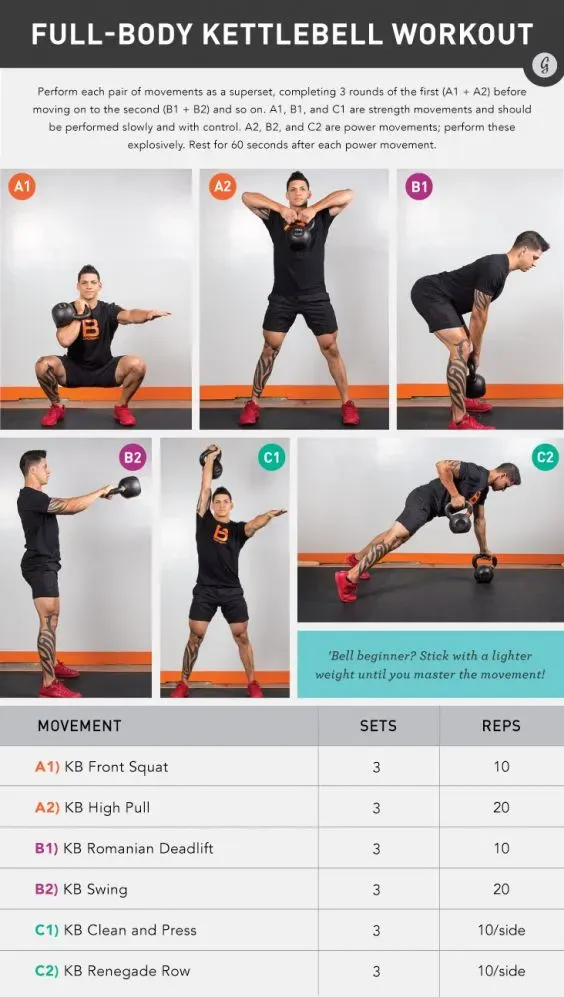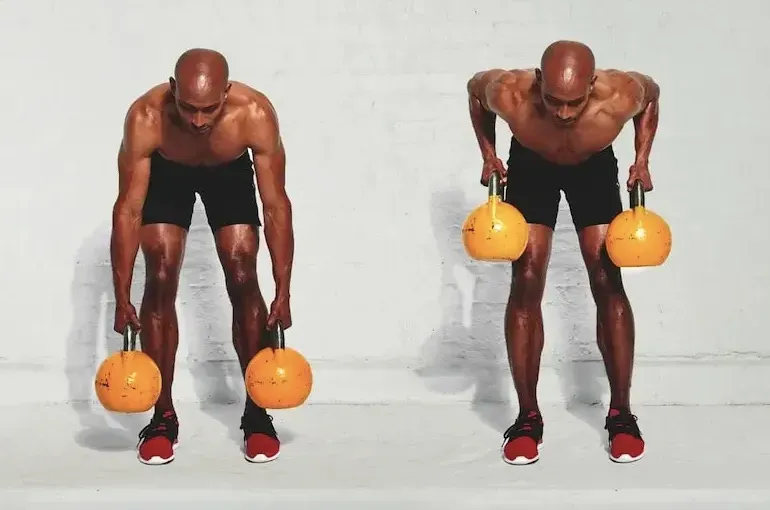Table of Contents
Let's be honest, dragging yourself to a crowded gym isn't always happening. Life gets in the way, motivation waxes and wanes, and sometimes you just want to sweat it out without the commute or the questionable locker room smells. If you've got a kettlebell gathering dust in a corner, or you're thinking about getting one, you've got a serious tool for serious fitness right under your roof. Forget those endless, boring cardio sessions or complicated machine routines. A solid full body kettlebell workout at home can torch calories, build functional strength, and improve your mobility, all in surprisingly little time.
Why the Kettlebell is Perfect for Your Home Gym

Why the Kettlebell is Perfect for Your Home Gym
Alright, so you're thinking about setting up a home workout space, but the idea of a full rack of dumbbells or a bulky machine makes your wallet weep and your living room shrink. This is exactly where the humble kettlebell shines. Unlike static weights, that weird cannonball shape with a handle forces you to control momentum and engage stabilizer muscles you didn't even know you had. It's not just about lifting; it's about swinging, cleaning, and pressing, hitting multiple muscle groups in one fluid motion. That means you get more work done in less time, which is gold when you're squeezing in a session between meetings or after the kids are in bed. Seriously, one or two kettlebells can provide a killer full body kettlebell workout at home that’s both strength-building and cardio-challenging.
Essential Exercises for Your full body kettlebell workout at home

Essential Exercises for Your full body kettlebell workout at home
Master the Kettlebell Swing
Look, if you're only going to learn one kettlebell exercise for your full body kettlebell workout at home, make it the swing. This isn't some gentle little movement; it's a powerful, explosive hip hinge that works your glutes, hamstrings, back, and even your core like nothing else. Think of it as a standing broad jump, but with a weight. You're not lifting the kettlebell with your arms; you're driving it forward with your hips. It’s a dynamic movement that gets your heart rate up fast and builds serious power in your posterior chain – the engine of your body. Getting the hinge right is crucial. Your back stays flat, chest up, and the power comes from snapping your hips forward, like you're trying to throw the kettlebell through a wall in front of you.
Get Low with the Goblet Squat
Forget the barbell on your back for a minute. The goblet squat, holding the kettlebell at your chest, is arguably one of the best ways to learn proper squat form and load your lower body effectively during a full body kettlebell workout at home. The weight in front acts as a counterbalance, making it easier to keep your chest upright and sink deep into a squat, hitting depth without your back rounding over. It hammers your quads, glutes, and even your core because you have to brace hard to keep the weight stable. It's a fundamental movement pattern, and doing it well with a kettlebell translates to strength in countless other activities, from picking up groceries to jumping onto a box.
Here are a couple of foundational kettlebell moves to build your base:
- The Swing: Explosive hip hinge, power from the glutes and hamstrings. Not an arm lift!
- The Goblet Squat: Kettlebell held at chest, focus on depth and keeping chest up. Great for form.
- The Turkish Get-Up: A complex, full-body movement from lying to standing. Builds stability and strength everywhere.
- The Clean: Transitioning the kettlebell from the floor or swing to the rack position (at the chest/shoulder).
- The Press: Lifting the kettlebell from the rack position overhead.
Clean and Press for Upper Body Power
Once you've got the swing and squat down, adding the clean and press brings the upper body into the fold for a truly comprehensive full body kettlebell workout at home. The clean is another dynamic movement, using your hips to drive the kettlebell up to the "rack" position at your chest/shoulder. It works your traps, shoulders, and requires solid coordination. From there, the overhead press is a fantastic way to build shoulder and triceps strength, plus core stability to prevent your back from arching. Doing these two moves together is a brutal, efficient way to build upper body pushing power and shoulder health. Just remember, the clean is less about pulling with your arms and more about absorbing the weight gracefully at the top of the hip drive.
Structuring an Effective full body kettlebell workout at home Routine

Structuring an Effective full body kettlebell workout at home Routine
Why Winging It Won't Cut It
Look, just grabbing the kettlebell and doing some swings until you're tired isn't a sustainable plan for a full body kettlebell workout at home. You need structure, a method to the madness, otherwise you're just exercising, not training. Training implies progression, a goal, and a path to get there. Think about it: if you just randomly lift weights, you might get a little stronger, but you won't maximize your potential or target specific weaknesses. A well-structured routine ensures you hit all major muscle groups, manage fatigue, and actually make progress over time. It takes the guesswork out of your session and lets you focus on the movement quality and intensity. Nobody got seriously strong by just showing up and doing whatever felt right that day.
Building Your Session: Sets, Reps, and Flow
So, how do you actually put a full body kettlebell workout at home together? Start with compound movements that use the most energy. Swings are a great opener to get the blood flowing and activate the posterior chain. Follow that with a heavy hitter like goblet squats or maybe some clean and presses. Then, move to slightly less demanding but still crucial exercises. You can structure it in a few ways: traditional sets and reps (like 3 sets of 10 swings), circuits (move from one exercise to the next with minimal rest), or even EMOMs (Every Minute On the Minute) for intensity. The key is choosing a structure that fits your goals and time constraints. Don't try to do everything every day; pick a few key movements per session and focus on quality over quantity. Rest periods are important too; don't just flop around like a fish out of water between sets. Catch your breath, stay focused.
Here's a simple structure example:
- Warm-up (5-10 minutes dynamic stretches)
- Main Lifts (e.g., Swings, Goblet Squats, Clean & Press) - Choose 3-4 exercises.
- Accessory Work (e.g., Rows, Lunges, Push-ups) - Choose 1-2 exercises.
- Cool-down (5 minutes static stretching)
Consistency is King, Progression is Queen
You can have the most perfectly designed full body kettlebell workout at home routine on paper, but if you don't actually do it consistently, it's useless. Aim for 3-4 sessions per week, leaving a rest day in between. Your muscles grow when they're recovering, not when you're constantly beating them up. And once you can comfortably complete your sets and reps, it's time to make it harder. This is progression. You can do this by using a heavier kettlebell, doing more reps or sets, shortening rest times, or attempting more complex variations of the exercises you've mastered. Sticking with the same weight and reps forever is a surefire way to plateau and get bored. Keep challenging yourself, but don't jump too far too fast – that's a fast track to injury.
Avoiding Pitfalls in Your full body kettlebell workout at home Journey
Ignoring Form is a Recipe for Disaster
So you've got your kettlebell, you're hyped, and you just start swinging or squatting with whatever feels "heavy." Stop right there. The absolute quickest way to get injured and make zero progress with your full body kettlebell workout at home is to ignore proper form. That dynamic nature of the kettlebell? It’s a double-edged sword. If you're not controlling the weight and moving correctly, you're putting stress on your joints and spine in ways you absolutely don't want. Think about the swing: if you're squatting it instead of hinging, you're loading your lower back improperly. If your overhead press looks more like a struggle-bus lean, your shoulder isn't happy. Take the time upfront to watch videos, maybe even record yourself, and nail down the foundational movements. It's boring, I know, but it pays off massively down the road.
Picking the Wrong Weight and Skipping Steps
Another classic mistake people make when starting a full body kettlebell workout at home is grabbing a weight that's way too heavy because their ego wrote the check their body can't cash. Or, conversely, they stick with a weight that’s too light for months on end. If you can't do 5-10 *quality* reps of an exercise like the swing or goblet squat with decent effort, that weight is probably too heavy for learning the movement. Start lighter than you think you need to master the technique. Then, progressively increase the weight when your sets feel easy. Also, don't skip the warm-up or cool-down. Your body isn't a machine you can just turn on and off. Preparing your muscles and joints, and then helping them recover, is non-negotiable if you want to stick with this long-term.
Common mistakes to actively dodge:
- Using your arms to lift the kettlebell during swings (it's a hip drive!)
- Rounding your back during squats or deadlifts
- Going too heavy before mastering the movement pattern
- Skipping warm-ups or cool-downs
- Doing too much, too soon, without adequate rest
- Trying complex moves like the Turkish Get-Up before nailing the basics
Beyond the Basics: Progressing Your Kettlebell Training

Beyond the Basics: Progressing Your Kettlebell Training
Taking Your Kettlebell Game Up a Notch
so you've nailed the basic movements – the swing feels powerful, your goblet squat is deep and controlled, and you can clean and press with decent form. What now? Sticking with the same weights and reps forever is a sure path to boredom and stalled progress. This is where you start thinking about making things harder. Maybe that means investing in a slightly heavier kettlebell, or maybe it means doing more reps or sets with the weight you have. You could also shorten your rest periods, which cranks up the conditioning aspect. Or, you could tackle more advanced variations of the exercises you know, like single-arm swings, front squats, or double kettlebell work if you have a pair. The goal is to keep challenging your body so it has a reason to adapt and get stronger.
- Use a heavier kettlebell when your current weight feels easy for your target reps.
- Increase the number of sets or repetitions for your key exercises.
- Shorten rest periods between sets to boost conditioning.
- Try more advanced exercise variations (single-arm swings, double kettlebell squats).
- Implement timed sets or EMOM protocols for intensity.
- Focus on increasing the speed and power of explosive movements like the swing.
Your Home Gym Powerhouse: Wrapping It Up
So there you have it. The kettlebell isn't just another piece of equipment destined for the garage sale pile. It's a legitimate, efficient tool for getting a serious full body workout right where you live. We've covered the essential moves, the logic behind structuring your routine, and hopefully steered you clear of the common mistakes people make when trying to build strength and endurance at home. It takes consistency, focus on form, and a willingness to push yourself, just like any effective training program. Stop making excuses about the gym and start swinging. Your body will thank you, probably with fewer aches and more ability to carry all the groceries in one trip.